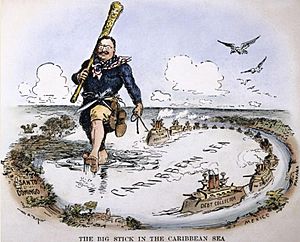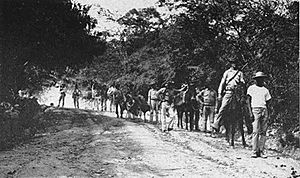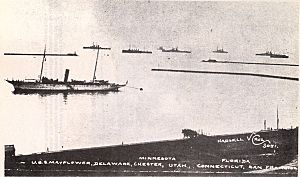Banana Wars facts for kids
Quick facts for kids Banana Wars |
|
|---|---|
 US Marines with the captured flag of Augusto César Sandino in Nicaragua in 1932. |
|
| Objective | To enforce United States interests in Central America and Caribbean |
| Date | April 21, 1898 – August 1, 1934 (36 years, 3 months, 1 week and 4 days) |
| Executed by | United States |
| Outcome | |
The Banana Wars were a group of military actions taken by the United States in countries like Central America and the Caribbean. These actions happened between 1898 and 1934. The main goal was for the U.S. to protect its interests in these regions.
Most of these military actions were carried out by the United States Marine Corps. They even wrote a guide called the Small Wars Manual based on what they learned. Sometimes, the United States Navy helped with ships and gunfire, and the United States Army also sent troops.
After the Spanish–American War ended in 1898, the U.S. gained control of Cuba, Puerto Rico, Guam, and the Philippines from Spain. Following this, the U.S. got involved militarily in Cuba, Panama, Honduras, Nicaragua, Mexico, Haiti, and the Dominican Republic. These conflicts ended when U.S. troops left Haiti in 1934, during President Franklin D. Roosevelt's time.
The name "Banana Wars" became popular in 1983, thanks to writer Lester D. Langley. He wrote books like The Banana Wars: An Inner History of American Empire, 1900–1934. His writings showed the U.S. acting like a police force in these tropical countries. This was to deal with conflicts, lawless areas, and corrupt leaders, helping the U.S. control trade in the region. Sadly, hundreds of American soldiers and thousands of local people died during these wars.
Contents
Why Did the US Get Involved?
A big reason for U.S. involvement was to protect its economic, political, and military interests. The U.S. wanted to keep its influence strong in the region. A major goal was also to keep the Panama Canal safe. This canal, which opened in 1914, was built by the U.S. to help global trade and show off its naval power.
Also, American companies like the United Fruit Company had a lot of money invested in growing bananas, tobacco, sugar cane, and other goods. These farms were all over the Caribbean, Central America, and northern South America. The U.S. wanted to protect these business interests.
Where Did the US Intervene?

The U.S. sent troops or got involved in many countries during this time:
- Panama: The U.S. had been involved in Panama since 1846. This involvement grew when the Panama Canal was being built. In 1903, Panama separated from Colombia with U.S. support. This allowed the U.S. to build and control the Panama Canal. The U.S. then took control of the Panama Canal Zone.
- Spanish–American War: In 1898, U.S. forces took control of Cuba and Puerto Rico from Spain. This war marked the beginning of the Banana Wars era.
- Cuba: The U.S. occupied Cuba from 1898 to 1902. It was also occupied again from 1906 to 1909, in 1912, and from 1917 to 1922. In 1903, the U.S. got a permanent lease on the Guantanamo Bay Naval Base.
- Dominican Republic: The U.S. took action here in 1903, 1904, and 1914. The country was occupied by the U.S. from 1916 to 1924. For example, when a rebellion damaged an American-owned sugar cane farm, U.S. troops were sent in. They took over a small castle and set up a military presence to protect their businesses.
- Nicaragua: The U.S. occupied Nicaragua almost continuously from 1912 to 1933. Troops were there to make sure Nicaragua's leaders didn't threaten U.S. interests. The U.S. said it wanted Nicaragua to elect "good men" who wouldn't cause problems for American businesses.
- Mexico: U.S. military involvement in Mexico was also about protecting business and political interests. The U.S. also fought the Border War from 1910–1919. This was to control people crossing the border and stop rebel attacks on U.S. land. In 1914, the U.S. occupied Veracruz to stop German weapons from reaching the Mexican government. The U.S. was also worried about Germany's growing influence in the region before World War I.
- Haiti: The U.S. occupied Haiti from 1915 to 1934. During this time, a new Haitian constitution was created. It allowed non-Haitians to own land, which was previously forbidden.
- Honduras: American companies like the United Fruit Company and Standard Fruit Company controlled Honduras's banana exports, land, and railways. U.S. troops were sent to Honduras many times between 1903 and 1925. The writer O. Henry even called Honduras a "banana republic" in 1904.
In 1904, President Theodore Roosevelt announced the Roosevelt Corollary to the Monroe Doctrine. This statement said the U.S. had the right to step in to help Caribbean and Central American countries if they couldn't pay their international debts. Later, President William Howard Taft used "Dollar Diplomacy". This policy focused on economic influence, but it was still backed by military force when needed, like in Nicaragua.
American Fruit Companies and Their Influence
The early history of Honduras was very unstable, both politically and economically. This was partly due to American companies getting involved in the country.
Companies like Vaccaro Brothers Company (later Standard Fruit Company) and Cuyamel Fruit Company made deals with the Honduran government. The United Fruit Company also made agreements through its smaller companies. These deals often gave the American companies exclusive rights to land. In return, they promised to build railroads in Honduras.
However, banana farms in Central America often faced problems like "Panama disease". This was a fungus that destroyed banana crops. When this happened, companies would often abandon the ruined farms. They would also destroy the railroads and other things they had built. This meant the agreements between the government and the companies were not always kept.
The main goal for these companies was to control the banana trade from growing to selling. They would even fund local fighters, presidential campaigns, and governments. Some historians say that the indirect involvement of American companies made the armed conflicts in these countries worse. More dangerous and modern weapons led to more violent wars.
In British Honduras (now Belize), things were different. Even though the United Fruit Company was the only banana exporter there, and it tried to influence the local government, the country did not suffer from the same instability and armed conflicts as its neighbors.
A Marine's View: Smedley Butler
One of the most active military officers in the Banana Wars was U.S. Marine Corps Major General Smedley Butler. He was nicknamed "Maverick Marine." He fought in Honduras in 1903 and helped enforce American policy in Nicaragua from 1909 to 1912. He earned the Medal of Honor twice for his bravery in Veracruz in 1914 and Haiti in 1915.
After he retired, Butler became a speaker. He often talked to groups who were against big businesses. His most famous speech was called "War Is a Racket." In it, he said he was "a high class muscle man for Big Business, for Wall Street and the bankers...a racketeer, a gangster for capitalism." He openly criticized the role he had played in these wars.
Images for kids
See also
 In Spanish: Guerras bananeras para niños
In Spanish: Guerras bananeras para niños







